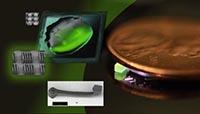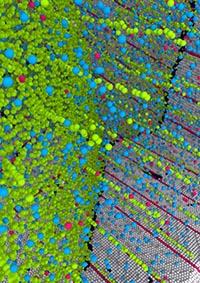LAB REPORT
Science and Technology Making Headlines
Oct. 11, 2019


Researchers have developed a method for detecting opioid drugs and drug metabolites in breath. Credit: Charles Wollertz/Getty Images
Breath test for opioids
A test to detect opioid drugs in exhaled breath has been developed by engineers and physicians at the University of California, Davis and Lawrence Livermore National Laboratory. The test could be useful in caring for chronic pain patients as well as for checking for illegal drug use.
The work is described in a paper published in the Journal of Breath Research on Oct. 3.
Doctors and nurses treating chronic pain may need to monitor patients to make sure they are taking their drugs correctly, that their prescribed drugs are being metabolized properly and that they are not taking additional medications. While blood tests are the gold standard, a reliable, noninvasive test would be a useful alternative.
For the test, subjects breathe normally into a specialized collection device. Droplets in breath condense and are stored in a freezer until testing. Mass spectrometry is used to identify compounds in the samples.
Lawrence Livermore researchers include Kristen Reese and Matthias Frank.


Lawrence Livermore has a comic book about the National Ignition Facility. Authored and illustrated by John Jett /LLNL
NIF goes graphical
When physicists talk about their research, members of the public may wince at the prospect of being deluged with complex technical information. Breaking from that tradition, Lawrence Livermore has published a full-color, 12-page comic book about its premier scientific research tool, the National Ignition Facility, or NIF.
Like other comic books, this one has panels of varying shapes and sizes, cartoon characters and speech bubbles that pose quick questions and give short answers. Unlike most, however, this one looks at a technical topic, unafraid to address the public’s uncertainty and perhaps intimidation when confronting science.
The comic has become a much-appreciated addition to the more traditional repertoire of tours and technical briefings for people who come to learn about the giant laser, according to author and illustrator John Jett of the Lab's Technical Information Department.


Using a new method of nanofabrication developed at Lawrence Livermore, engineers were able to produce a cuboid structure with nanoscale features that would take several hours with existing two-photon lithography technology in about eight minutes. Researchers also produced the thinnest nanowires ever printed by any similar system.
Ultrafast printing gets ultrafaster
Researchers from Lawrence Livermore (LLNL) and the Chinese University of Hong Kong have accelerated the rate of nanoscale additive manufacturing. Tackling what has long been a trade-off between resolution and time, the team has developed a method that could enable industrial-scale production of minute devices. The technique also is capable of creating previously impossible 3D structures with 90-degree overhangs.
Chris Spadaccini, director of LLNL’s Center for Engineered Materials and Manufacturing, calls the research “a breakthrough in nanoscale printing.”
The new method is part of a body of work that seeks to improve two-photon lithography. At present two-photon, or multi-photon, lithography is the most common method of 3D printing sub-micron structures. So far, it has been limited however by the speed at which it can 3D print.
In this latest research led by Sourabh Saha, a former LLNL engineer, the solution is to replace the singular laser typically used in two-photon lithography systems with a field of light, similar to those used in light projectors. This digital mask controls an ultrafast femtosecond laser, simultaneously projecting one million points into a material vat in a single pass.


This snapshot, from an atomistic computer simulation, is part of a recent study showing how impurities can be used to create a new class of super-strong-but-still-conductive materials called "nanocrystalline-nanotwinned metals." Image by Frederic Sansoz/UVM
World’s strongest silver
A team of scientists has made the strongest silver ever — 42 percent stronger than the previous world record. But that's not the important point.
"We've discovered a new mechanism at work at the nanoscale that allows us to make metals that are much stronger than anything ever made before — while not losing any electrical conductivity," says Frederic Sansoz, a materials scientist and mechanical engineering professor at the University of Vermont, who co-led the new discovery.
This fundamental breakthrough promises a new category of materials that can overcome a traditional trade-off in industrial and commercial materials between strength and ability to carry electrical current.
All metals have defects. These defects lead to undesirable qualities, like brittleness or softening. "We asked ourselves, how can we make a material with defects but overcome the softening while retaining the electroconductivity," said Morris Wang, a lead scientist at Lawrence Livermore National Laboratory and co-author of the new study.
By mixing a trace amount of copper into the silver, the team showed it can transform two types of inherent nanoscale defects into a powerful internal structure.


Americans used more energy in 2018 than in any other year, according to the most recent energy flow charts released by Lawrence Livermore National Laboratory.
Everything you need to know about energy use
If you feel like you’ve seen the diagram to the left before, you probably have.
Every year, it’s assembled by Lawrence Livermore National Laboratory. The ambitious aim is to chart all U.S. energy use in one Sankey diagram, including the original energy source — e.g., nuclear, oil, wind — as well as the ultimate end use — e.g., residential, commercial — for the energy that was generated.
According to the most recent version of the diagram, U.S. energy use totaled 101.2 quads in 2018. A single quad is equal to 1 quadrillion BTUs, with each quad being roughly equivalent to 185 million barrels of crude oil, 8 billion gallons of gasoline or 1 trillion cubic feet of natural gas.
U.S. energy use has been generally increasing, eventually topping 100 quads per year by 2018. During this time, the total percentage of fossil fuels in the mix has dropped, while the largest percentage increases in the mix have come from solar and wind sources.


Constantin Häfner has been appointed the new director of the Fraunhofer Institute for Laser Technology.
New leader for lasers
Lawrence Livermore laser physicist Constantin Häfner has been appointed the new director of the Fraunhofer Institute for Laser Technology (ILT). He also will hold the associated chair for laser technology LLT at RWTH Aachen University, which involves leading interdisciplinary research projects as part of the Research Center for Digital Photonic Production.
Häfner was previously program director for advanced photon technologies at Lawrence Livermore, where he led the development of the world’s most powerful laser systems and conducted R&D into pioneering laser technologies. Häfner led the team that developed the L3-HAPLS, the most advanced petwatt laser system.





